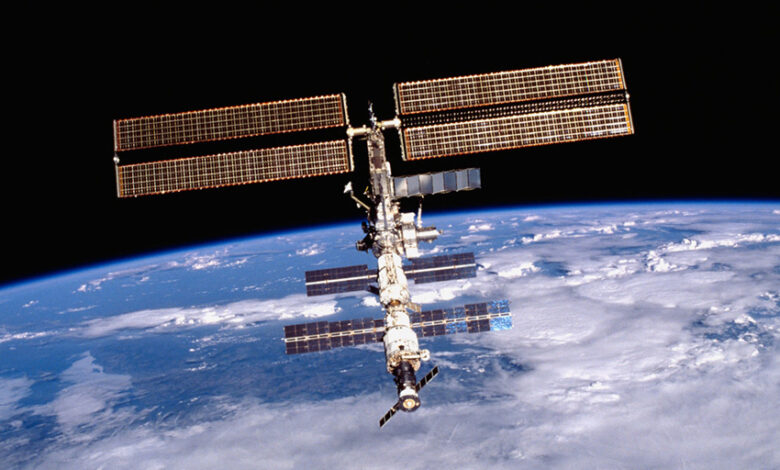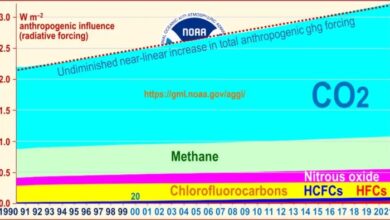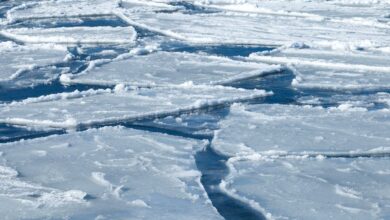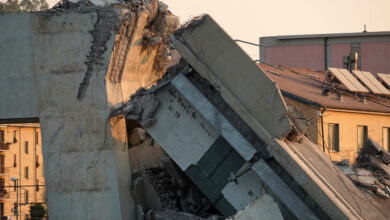What We Learned from the Space Station this Past Year – Watts Up With That?

As the International Space Station enters its third decade of continuous human presence, the impact of microgravity research conducted there keeps growing. The months between Nov. 2020 and Nov. 2021 saw publication of more than 400 scientific papers based on studies aboard the orbiting lab.
Here are some highlights of recent results from groundbreaking space station science:
More stem-ness in stem cells
Former NASA astronaut Peggy Whitson conducts operations for the Cardiac Stem Cells investigation.Credits: NASA
Spaceflight can affect cardiac function and structure, and scientists know that cardiovascular stem cells respond to these changes but do not clearly understand the biological basis for this response. NASA’s Cardiac Stem Cells investigation delved into how microgravity affects cardiac stem cells and the physical and molecular changes that govern their activity.
On Earth, cardiovascular stem cells, also known as cardiovascular progenitor cells or CPCs, can continually divide to produce more of the same type of cells or develop into other specialized cell types. In newborns, these cells develop into a greater variety of types of cardiovascular cells and produce greater numbers of cells than the same cells in the adult heart. That capability suggests that newborn or neonatal heart cells have the potential to be used to repair and replace worn out or damaged heart tissues.
According to a research study published in the International Journal of Molecular Sciences, this investigation revealed that space flight gives both adult and neonatal cells more “stemness,” which may improve their regeneration, survival, and proliferation. Understanding how to trigger this return to an earlier developmental state could have immense benefit in the field of regenerative medicine. This growing field uses stem cells and tissue engineering to regrow, repair, or replace damaged or diseased cells, organs, and tissues. Long-duration microgravity, a unique research variable offered by the space station, could provide a tool to activate stemness in adult CPCs.
Reducing radiation exposure
This image shows the ExHAM facility attached to the Japanese Experiment Module Airlock (JEMAL) slide table, which isused to move the facility to the exterior of the space station. Material samples are visible attached to the facility’s sides.Credits: NASA
ExHAM-Radiation Shielding, an investigation from Japan Aerospace Exploration Agency (JAXA), evaluates how the space environment affects materials that could be used to shield future spacecraft from cosmic rays and other types of ionizing radiation.
Researchers discovered that adding the mineral colemanite (a type of borax that forms when alkaline waters evaporate) to a polymer reduced the amount of radiation the material absorbed. Samples exposed to space radiation showed no significant difference from those that were not subjected to these harsh conditions. The compound could provide better radiation protection for satellite technology, low-Earth orbit stations, and high-altitude planes. These materials have potential applications in harsh environments on Earth as well.
Mighty miniature miners
This preflight image shows a biofilm of a microbe, Spingomonas desiccabilis, growing over and into the surface of basaltfor the Biorock experiment, which examined the effects of altered gravity on the interactions of rock, microbes, and liquid.Results suggest that biomining can work in microgravity and may be even more effective than it is on Earth.Credits: ESA
The electronics and alloy production industries use microorganisms to mine economically important elements from rocks. Results of an investigation from ESA (European Space Agency) suggest that this technique, known as biomining, could be as or even more effective on the Moon and Mars as on Earth.
Biorock demonstrated that microbes can extract rare Earth elements from basalt (a common rock on the Moon and Mars) in space. The team revealed in a recent paper that microbes may perform even better in microgravity, reporting an increase of as much as 283% in vanadium biomining on the space station. That means we could use biomining to extract elements needed to sustain humans independently of Earth.
Mining with microbes reduces the need for chemicals that can be damaging to the environment, uses very little energy, and is compact, an important consideration for deep space exploration and its limits on the materials that can be brought from Earth.
A closer look at cement
NASA astronauts Anne McClain and Serena Auñón-Chancellor during operations for the MICS experiment, which examinedsolidification of cement in microgravity.Credits: NASA
Humans who go to the Moon or Mars to stay need to be able to construct safe places in which to live and work. Concrete, the most widely used building material on Earth, is strong and durable enough to provide protection from cosmic radiation and meteorites, and it might even be possible to make it using materials available on these celestial bodies. The MICS investigation mixed cement powders with various additives and amounts of water to examine the chemistry and microscopic structures involved in the solidification process and determine whether changes in gravity might affect it.
A paper in the journal Construction and Building Materials reports results from some of those tests. In mixtures of tricalcium aluminate and gypsum, microgravity caused unique microstructures, including striations or lines in the gypsum. These striated microstructures were highly porous and trapped air, which could affect the strength of the material. Samples mixed on Earth showed more developed microstructure with a higher degree of hydration. These findings could contribute to the development of new materials for the construction of extraterrestrial habitats and improved materials on Earth.
Another investigation currently under way on station, Redwire Regolith Print, also works toward that goal. That experiment tests using a material that simulates regolith, or the loose rock and soil found on the Moon and Mars, to create objects via 3D printing with the station’s Made In Space Additive Manufacturing Facility.
Getting a leg up on cardiovascular issues
Roscosmos Plethysmograph Unit used for the Cardio-ODNT investigation of leg vein health. Plethysmography measureschanges in volume in specific areas of the body, including the blood vessels.Credits: NASA
Cardio-ODNT, an investigation from the Russian space agency Roscosmos, examined leg vein health in crew members on two 6-month spaceflight missions. Previous studies have demonstrated that vein structure can change shortly after arrival to the space station, primarily from the hips down.
Published results show that participating in two missions did not worsen leg vein health so long as the crew members had substantial time between flights and good muscular health in their lower extremities, which supports vein structure and function. The findings suggest that physical exercise could provide an effective countermeasure for space-related cardiovascular issues.
Earth’s atmosphere at night
The Mini-EUSO telescope during assembly.Credits: JEM-EUSO
Roscosmos-ASI Mini-EUSO is generating data with potential applications for responding to climate effects, marine pollution, geomagnetic disturbances, space debris, and meteors. A multipurpose telescope designed to operate at night, Mini-EUSO is part of JEM-EUSO, a larger program involving about 300 scientists from 16 countries working to enhance the observation of cosmic rays. The telescope observes atmospheric phenomena such as lightning-like Transient Luminous Events (TLEs), meteors, Strange Quark Matter (SQM), and cosmic ray showers. It could be a first step toward mapping space debris for potential removal via laser and supports creation of a dynamic map of nocturnal ultraviolet emissions from Earth.
A paper published in The Astrophysical Journal reports that six months of operation indicate that Mini-EUSO operates as expected, measuring variations in airglow and ultraviolet emissions from Earth and tracking space debris and ultrahigh-energy cosmic rays.
Predicting and preventing bone loss
This image shows preflight collection of baseline bone density data from Canadian Space Agency(CSA) astronaut David Saint-Jacques for the TBone study, which assessed the effect of space flighton bone quality using high-tech measurements of bone density and structure.Credits: NASA
Long-duration spaceflight poses a risk to the health of crew members’ bones, particularly the weight-bearing ones. Researchers for NASA’s Biochem Profile and the Canadian Space Agency (CSA) TBone investigations examined changes in microarchitecture, density, and strength of bones in the lower leg and arm during spaceflight and the relationships among mission duration, biochemical markers associated with bone resorption and formation, and exercise.
Their findings, published in the British Journal of Sports Medicine, suggest that bone loss in some astronauts could be predicted by elevation of certain biomarkers preflight and that bone biomarkers and exercise history can help identify astronauts at greater risk for bone loss. Crew members who increased their resistance training during flight were more likely to preserve bone strength, but whether current in-flight exercise regimes are sufficient warrants further examination. These findings also have relevance for understanding how exercise affects bone loss on Earth such as that caused by reduced mechanical loading due to injury, disuse, or disease.
Characterizing sooty flames in space
A flame ignited as part of Flame Design, which investigates the amount of soot that is produced in different conditions.The yellow spots are soot clusters that glow yellow when hot. These clusters grow larger in microgravity than on Earthbecause the soot remains within the flame longer.Credits: NASA
Flame Design, part of the Advanced Combustion via Microgravity Experiments (ACME) project, studies the production and control of soot. Because soot can adversely affect the efficiency and emissions from flames and equipment lifetime, results could lead to more efficient and cleaner burner designs. The experiment is conducted with spherical flames of gaseous fuels in the Combustion Integrated Rack (CIR).
Researchers reported a number of observations in a paper published in Combustion and Flame Journal, including rate of growth in flames, coupling of burner heating and flame radius, oscillations as flames start to go out, relationship between fuel flow rates and flame temperature, and irradiance in flames with increasing or nearly constant peak gas temperature. These observations enhance the understanding of fire behavior and could help keep people safer in spacecraft and on Earth.
Blue jets, blue bangs, and better atmospheric models
A blue jet reaching 30 km upwards into the stratospherecaptured by ASIM’s instruments on the space station.Credits: DTU Space, ESA, NASA
ESA’s ASIM, an observation facility on the outside of the space station, is used to study severe thunderstorms and their role in Earth’s atmosphere and climate. The work has revealed the mechanism behind the creation of the bright flashes we call lightning and helped researchers to determine the sequence of events that produces high-energy terrestrial gamma-ray flashes, or TGFs.
Recently published results add to our understanding of the physical properties of another atmospheric phenomenon – blue jets, or the electric discharges generated by disturbances of positively and negatively charged regions in the upper levels of the clouds. ASIM measurements show that blue jets may originate with a “blue bang” in a cloud top. The study also shows that the explosive onset and the jet itself both are made primarily of streamer ionization waves, with only faint signatures of leader activity that would be expected for normal lightning. By helping scientists better understand how thunderstorms affect Earth’s atmosphere, ASIM contributes to better atmospheric models and meteorological and climatological predictions.
Check out what we learned from the space station in 2020. Keep up with current research by following @ISS_Research, Space Station Research and Technology News or our Facebook.
Melissa Gaskill
International Space Station Program Research Office
Johnson Space Center
Last Updated: Dec 27, 2021
Editor: Ana Guzman












